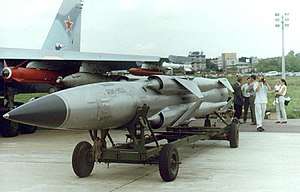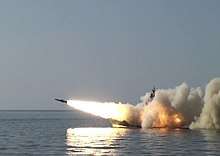P-270 Moskit
The P-270 Moskit (Russian: П-270 «Москит»; English: Mosquito) is a Soviet supersonic ramjet powered anti-ship cruise missile. Its GRAU designation is 3M80, air launched variant is the Kh-41 and its NATO reporting name is SS-N-22 Sunburn. The missile system was designed by the Raduga Design Bureau during the 1970s as a follow up to the P-120 Malakhit (NATO reporting name "SS-N-9 Siren"). The Moskit was originally designed to be ship-launched, but variants have been adapted to be launched from land (modified trucks), underwater (submarines) and air (reportedly the Sukhoi Su-33, a naval variant of the Sukhoi Su-27), as well as on the Lun-class ekranoplan. The missile can carry conventional and nuclear warheads. The exact classification of the missile is unknown, with varying types reported. This uncertainty is due to the secrecy surrounding an active military weapon. The missile has been purchased and exported to the People's Liberation Army Navy (China) and Indian Navy (India).
| Moskit | |
|---|---|
 Moskit missile at MAKS, Zhukovskiy, 1999. Note that the fins are folded for storage. When deployed, they protrude at 90 degrees from the missile centerline. | |
| Type | Anti-ship missile |
| Place of origin | Soviet Union |
| Service history | |
| In service | 1984, the first ship with 3M80 missiles was actually ready in 1978, formally adopted in 1981[1] |
| Used by | Soviet Union, Russia, China, Egypt |
| Production history | |
| Manufacturer | MKB Raduga |
| Produced | 1983 |
| Specifications | |
| Mass | 4,500 kg (9,900 lb) |
| Length | 9.745 m (31.97 ft) |
| Diameter | 0.8 m (2.6 ft) |
| Warhead | 300 KG (660 lb) overall 150 kg (330 lb) explosive or 120 kt of TNT fission-fusion thermonuclear weapon |
| Engine | Four ramjets (solid fuel rocket on air-to-surface version) |
| Wingspan | 2.10 m (6.9 ft) |
Operational range | 120–250 km (75–155 mi) |
| Flight altitude | 20 m (66 ft) above sea level |
| Maximum speed | Mach 3 (3,675 km/h; 2,284 mph)[2] |
Guidance system | inertial guidance plus terminal active radar homing |
Launch platform | naval ships, fixed-wing aircraft, coastal and road mobile TEL |
Design

It reaches a speed of Mach 3 (3,675 km/h; 2,284 mph) at high altitude and Mach 2.2 at low-altitude. This speed is 4.25 to 3 times more than speed of the subsonic American Harpoon. The Moskit was designed to be employed against smaller NATO naval groups in the Baltic Sea (Danish and German) and the Black Sea (Turkish) and non-NATO vessels in the Pacific (Japanese, South Korean, etc.), and to defend the Russian mainland against NATO amphibious assault.[3] The missile can perform intensive anti-defense maneuvers with overloads in excess of 10g, which completed for 9 km before the target.[1][4][5]
Variants of the missile have been designated 3M80M, 3M82 (Moskit M).[6] The P-270 designation is believed to be the initial product codename for the class of missile, with the Russian Ministry of Defense GRAU indices (starting with 3M) designating the exact variant of the missile. The 3M80 was its original model. The 3M80M model (also termed 3M80E for export) was a 1984 longer range version of the missile, with the latest version with the longest range being the 3M82 Moskit M. The ASM-MSS / Kh-41 variant is the 1993 air-launched version of the missile.[7]
The 3M80MVE variant has an optional longer 240 km range through a second, high-altitude flight profile setting, however using the higher altitude profile would make the missile detectable at much greater distances.[8]
Specifications

- Launch range:
- min: 10–12 km (6.2–7.5 mi; 5.4–6.5 nmi)
- Maximum firing range:[1]
- 3M80E – 120 km (75 mi; 65 nmi) (surface ship)
- 3M80MVE – 140 km (87 mi; 76 nmi) (surface ship, low-altitude trajectory); 240 km (150 mi; 130 nmi) (surface ship, combined trajectory)
- Missile flight speed: 2,800 km/h (1,700 mph; Mach 2.3)
- Missile cruising altitude: 10 – 20 m (low-altitude trajectory), under 7 m for the attack at the target.[1][10]
- Launch sector relative to ship’s lateral plane, ang.deg: ±60
- Launch readiness time:
- From missile power-on till first launch: 50 seconds
- From combat-ready status: 11 seconds
- Inter-missile launch time (in a salvo): 5 seconds
- Launch weight:
- 3M-80E missile 4,150 kg (9,150 lb)
- 3M-80E1 missile 3,970 kg (8,750 lb)
- Warhead type: penetrator
- Warhead weight: 300 kg (explosives 150)
- Dimensions:
- Length: 9.385 m
- Body diameter: 0.8 m
- Wing span: 2.1 m
- Folded wing/empennage span: 1.3 m
Variants
- P-80 Zubr shorter dimensions and range.
- P-270 Moskit ' Sunburn ' longer range and dimensions, maybe faster.
- Kh-41 air launched AGM (air-to-ground missile) or AShM (anti-ship missile).
- 3M-80MVE Coastal Anti-Ship, GLCM (ground launch cruise missile), LACM (land attack cruise missile) variants, SSC-7/12 .
Operators







Former operators
Notes
- "Противокорабельная ракета 3M80 (3М80Е) Москит". Retrieved 8 October 2015.
- "Moskit / SS-N-22 Sunburn". Retrieved 1 October 2014.
- "dtig.org" (PDF). Archived from the original (PDF) on 5 February 2012. Retrieved 8 October 2015.
- "ПКР Москит". Retrieved 8 October 2015.
- "Вооружение РКВП "Бора" и "Самум" Черноморского флота". Archived from the original on 23 September 2015. Retrieved 8 October 2015.
- "eDefense - Detect. Decide. Shoot. Survive". Archived from the original on 30 April 2006. Retrieved 1 October 2014.
- "Archived copy". Archived from the original on 6 August 2014. Retrieved 25 August 2016.CS1 maint: archived copy as title (link)
- Gormley, Dennis M.; Erickson, Andrew S.; Yuan, Jingdong (30 September 2014). "A Potent Vector: Assessing Chinese Cruise Missile Developments". Joint Forces Quarterly. National Defense University (75): 102.
- "Х-41". Retrieved 8 October 2015.
- http://www.airwar.ru/weapon/pkr/moskit.html
- "ГВАРДЕЙСКИЙ РАКЕТНЫЙ КАТЕР "Р-32" ПЕРЕДАН ЕГИПТУ". balabin-1712.livejournal.com (in Russian). 13 August 2015. Archived from the original on 13 August 2015.
References
External links
| Wikimedia Commons has media related to P-270 Moskit. |